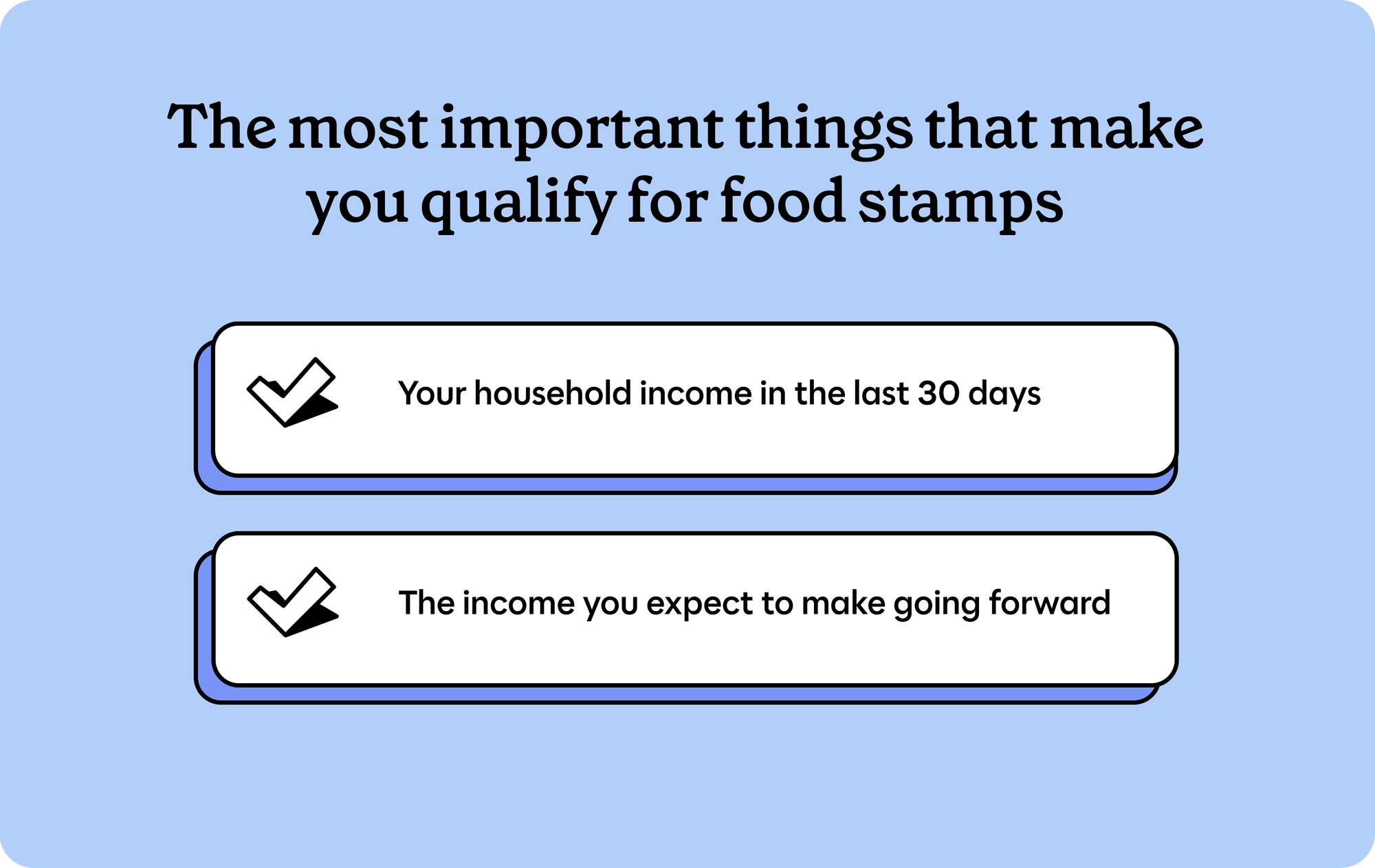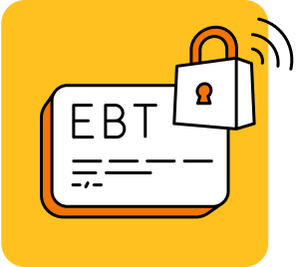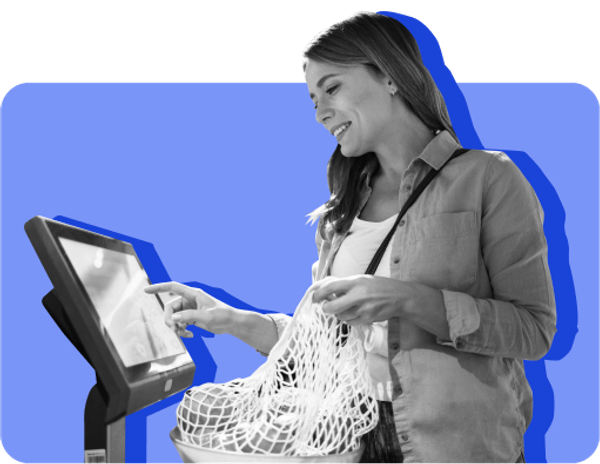How to qualify for food stamps, explained



Additional expert review by
- How much money can I make and still qualify for food stamps?
- How much can I make per year and still qualify for food stamps?
- What if I have an unexpected change in my income, can I still qualify food stamps?
- Can I qualify for food stamps if I do gig work, or if I’m an independent contractor?
- How do I calculate my gross income for food stamps if I pay or receive child support?
- “Gross income” vs. “net income” limits for food stamps
- How much money can you have in your bank account and still qualify for food stamps?
- Can you own a car and get food stamps?
- Can you get food stamps if you own your house?
- Can you get food stamps as a college student?
- How long does it take to qualify for food stamps?
- How do I qualify for emergency (expedited) food stamps?
- Summary
Table of contents
- How much money can I make and still qualify for food stamps?
- How much can I make per year and still qualify for food stamps?
- What if I have an unexpected change in my income, can I still qualify food stamps?
- Can I qualify for food stamps if I do gig work, or if I’m an independent contractor?
- How do I calculate my gross income for food stamps if I pay or receive child support?
- “Gross income” vs. “net income” limits for food stamps
- How much money can you have in your bank account and still qualify for food stamps?
- Can you own a car and get food stamps?
- Can you get food stamps if you own your house?
- Can you get food stamps as a college student?
- How long does it take to qualify for food stamps?
- How do I qualify for emergency (expedited) food stamps?
- Summary
Getting food stamps depends primarily on three key factors: your monthly income, household size, and immigration status. Many people are surprised to learn that having savings, owning a car, or having a house typically won't affect their eligibility or benefit amount.
- Income: You need to make less than the gross income limit for your household size. For example, a single person typically needs to make $2,510 or less per month before taxes.
- Household size: Your household includes the people you buy and prepare food with. The more people in your household, the higher the income limit will be for food stamps/
- Immigration status: You must be a U.S. citizen or have an eligible immigration status to get food stamps. Some immigrants like refugees and asylees may qualify immediately, while lawful permanent residents and Green Card holders typically need to wait 5 years.
Even college students may qualify for food stamps (also called SNAP benefits or EBT) in certain situations. For those facing immediate financial hardship with very limited funds available, emergency food stamps might be accessible within seven days.
How much money can I make and still qualify for food stamps?#how-much-money-can-i-make-and-still-qualify-for-food-stamps

The most important numbers that determine if you qualify for food stamps are:
- Your household income in the last 30 days
- The monthly income you expect to make going forward
For example, if you just lost your job, you may become newly eligible for food stamps—even if you didn’t qualify before.
Your “household” for food stamps generally means the people you buy and prepare food with, though there are some exceptions. Learn more about how SNAP households are determined.
Before we get into the details, there are some personal finance words you need to know. Gross income is the money that you make before taxes are taken out. Net income is the money that you make after taxes are taken out.
In most states, people have to pass two income tests to qualify for SNAP. The first test is whether you make less than or equal to the gross income limit for your household size.
| Household size | Maximum gross income per month |
|---|---|
| 1 | $2,510 |
| 2 | $3,408 |
| 3 | $4,304 |
| 4 | $5,200 |
| 5 | $6,098 |
| 6 | $6,994 |
| 7 | $7,890 |
| 8 | $8,788 |
Here’s how to read this:
- If you’re a single person household, you need to make $2,510 or less per month before taxes to possibly qualify for food stamps
- If you’re part of a married couple, you would need to make less than $3,408 per month combined before taxes to possibly qualify
- If you’re in a family of 4, you would have to make less than $5,200 per month before taxes to possibly qualify
Gross income limits are different in each state. The chart reflects the highest income limits across the country that allow someone to qualify for food stamps. There are also different income rules for households with seniors, people with disabilities, or mixed immigration statuses.
How much can I make per year and still qualify for food stamps?#how-much-can-i-make-per-year-and-still-qualify-for-food-stamps
Here is what the monthly gross income limits for food stamps are when converted to a full year:
| Household size | Maximum gross income per year |
|---|---|
| 1 | $30,120 |
| 2 | $40,896 |
| 3 | $51,648 |
| 4 | $62,400 |
| 5 | $73,176 |
| 6 | $83,928 |
| 7 | $94,680 |
| 8 | $105,456 |
Key tip: Food stamp eligibility is based on your income from the last 30 days. That's why the first chart shows income per month.
Get help with your utility bills
SNAP participants are often automatically eligible for utility assistance. Check out our guide to LIHEAP energy assistance 2024-2025 to learn more.
What if I have an unexpected change in my income, can I still qualify food stamps?#what-if-i-have-an-unexpected-change-in-my-income-can-i-still-qualify-food-stamps
You can still qualify for food stamps if your income suddenly goes down. For example if:
- You lost a job
- Your unemployment benefits ended
This is why it's important to remember that eligibility is determined by your recent income—not your annual income. Even if you make more money most months, you can still qualify for food stamps based on your recent income.
But if your income suddenly goes up, you’ll need to report that to your local agency. Your benefit amount may go down, or you may no longer qualify for food stamps if your income goes up a lot.
Can I qualify for food stamps if I do gig work, or if I’m an independent contractor?#can-i-qualify-for-food-stamps-if-i-do-gig-work-or-if-im-an-independent-contractor
Gig workers for companies like Doordash, Uber, Lyft, or Instacart can qualify for food stamps. When applying, your gig work is considered self-employment income.
Here's how your income as a gig or hourly-worker is calculated for food stamps:
- The standard calculation counts only 60% of your total earnings. This means you can subtract 40% from your gross income to see if you qualify.
- If your work expenses like gas and car insurance are higher than 40% of your income, you can choose to deduct your actual expenses instead. In this case, your qualifying income would be what remains after subtracting all your work-related costs.
If you've been doing gig work for a little while, you can use your tax return (Schedule C) to see what your gross income is. You can also use your tax return to prove your income when you apply for SNAP benefits.
For more information about SNAP for self-employed and gig work, take a look at this guide from Massachusetts Legal Services. Even if you live in a different state, the information is still helpful.
How do I calculate my gross income for food stamps if I pay or receive child support?#how-do-i-calculate-my-gross-income-for-food-stamps-if-i-pay-or-receive-child-support
When calculating your gross income, the rules for child support are straightforward: add any child support payments you receive, and subtract any child support payments you make to others.
“Gross income” vs. “net income” limits for food stamps#gross-income-vs-net-income-limits-for-food-stamps
Earlier, we noted that gross income is how much money you make before taxes are taken out. Net income is how much money you make after taxes are taken out.
If your gross income is under the gross income limit, the next step is to pass the SNAP net income test.
Typically, “net income” refers to take-home pay after taxes, but the calculation for SNAP is more complicated. Some household living expenses count as “deductions” in the SNAP net income test that can help reduce what your SNAP agency counts as your net income
Some of the expenses that count as deductions include:
- Rent, mortgage, or other housing costs
- Childcare costs
Medical expenses (for seniors and people with disabilities)
Important: If you have any of these costs, make sure to send in documents of proof when you apply. Proving these expenses can increase your monthly benefit.
Since the net income test involves more factors, we recommend that if you're under the gross income limit, you should go ahead and apply for food stamps.
How much money can you have in your bank account and still qualify for food stamps?#how-much-money-can-you-have-in-your-bank-account-and-still-qualify-for-food-stamps
For most people in most states, your bank savings do not matter for food stamp eligibility.
It’s important to know that food stamp eligibility is mostly about income: money you expect to get every month.
Income that you get every month is different from what is called “assets” (or “resources” or “property”).
Savings in a bank account, retirement investments, and valuable property like a house or a car are all considered assets. They do not count as income when determining eligibility for food stamps.
Thirteen states will still consider your assets for food stamps, but in most states, having assets will not affect your eligibility.
Can you own a car and get food stamps?#can-you-own-a-car-and-get-food-stamps
The short answer is yes, you can own a car and get food stamps.
Most states do not count vehicles as part of your household’s money when determining if you qualify for SNAP benefits. Even in states that do consider vehicles, they typically don't count your car if:
- You use it to earn income (like for delivery work)
- You need it for work travel beyond daily commuting
- You use it to transport a disabled household member
- It's worth less than $4,650
- It's your only vehicle
Can you get food stamps if you own your house?#can-you-get-food-stamps-if-you-own-your-house
Yes, a home and its property area are not considered resources or assets.
However, if you are renting rooms out, even to help pay a mortgage or other bills, that could count as income and impact your eligibility and/or the amount of benefits you will receive.
Can you get food stamps as a college student?#can-you-get-food-stamps-as-a-college-student
For food stamps purposes, the student rules only apply if you're taking at least half-time credits in college or vocational school. Your school sets what counts as half-time enrollment.
If you're a student but you're enrolled less than half of the time, then you are not eligible for food stamps.
If you are enrolled at least half-time, then you can only get food stamps if you meet one of these exceptions:
- Work: You work at least 20 hours a week
- Age: You are 17 or younger or 50 or older
- Disability: You are physically or mentally unable to work
- Being a caregiver: You care for a young child or disabled person
- Other programs: You are in certain work-study or job training programs or receive Temporary Assistance for Needy Families (TANF) benefits
How long does it take to qualify for food stamps?#how-long-does-it-take-to-qualify-for-food-stamps
After you apply for food stamps, the agency has 30 days to determine if you qualify.
Here’s what that process looks like:
- First, they compare your application details against state databases.
- Next, they review any documents you provided, such as pay stubs, proof of immigration status, and living expenses.
- You'll then have a phone interview with an eligibility worker who will verify your information. If anything is missing or needs clarification, they'll explain what additional documents you need and when to submit them.
- Once they've verified everything through databases and your documentation, they'll make a decision. You'll receive notice of whether you're approved, how much you'll receive in benefits, or why your application was denied.
If you have very little income and assets available, you may be able to get food stamps in seven days or less through emergency (expedited) processing.
How do I qualify for emergency (expedited) food stamps?#how-do-i-qualify-for-emergency-expedited-food-stamps
You may be eligible for faster processing of your application (called “emergency” or “expedited” food stamps) if any of these are true for you:
- You have $150 or less in monthly income and $100 or less in money on hand
- Your monthly rent and utilities are more than your income and money on hand, combined
- You are a migrant worker with $100 or less
You do not need to do anything special to qualify for these. The agency will see if you qualify for this based on what you put on your application.
Important tip: If you are in an emergency situation and need food stamps as soon as possible, consider going in person to your closest office (instead of applying online or by phone). They may be able to complete your application, your eligibility interview, and give you an EBT card all on the same day. Bring an identification card (ID) if you have one.
Summary#summary
Food stamp eligibility mainly depends on three factors:
- Your monthly income from the last 30 days must be under the limit for your household size
- Your household includes everyone who buys and prepares food together
- You must be a U.S. citizen or have eligible immigration status
Important things to remember:
- In most states, having savings or owning a car or house won't affect your eligibility
- The application process typically takes 30 days, but you could get benefits in seven days if you have very little money on hand
- If your income changes suddenly (like losing a job), you may become newly eligible
- College students, gig workers, and self-employed people can qualify under certain conditions
- Proving expenses like rent, childcare, and medical costs can help you get more benefits








